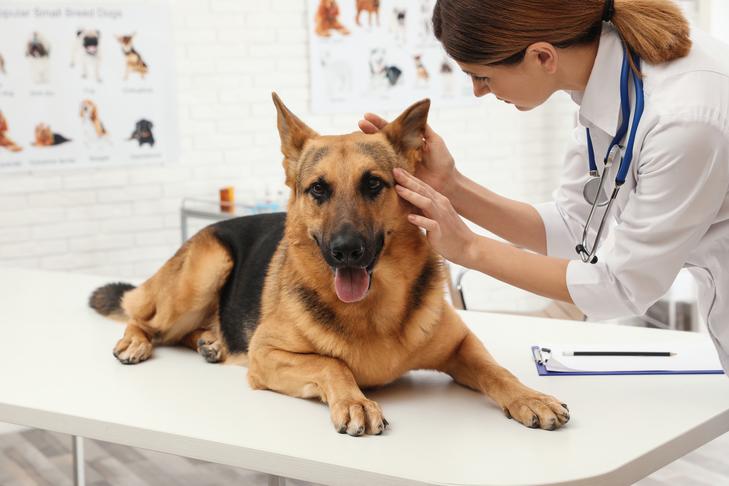Whether on the news or through updates from the Centers for Disease Control and Prevention (CDC), you may have heard about Candida auris. The World Health Organization (WHO) has named Candida auris one of the world’s four critical priority fungal pathogens, which as microorganisms that cause disease. A potentially deadly type of fungus that was first reported in Japan in 2009, Candida auris can appear in dogs’ ears.
Given concerns about the spread of this pathogen in healthcare settings, you might be wondering about the risk to yourself and your dog. Here’s what to know about Candida auris in dogs, including symptoms, diagnosis, prevention, and treatment.
What Is Candida Auris?
Candida is a species of yeast, which is a type of fungus that consists of a single cell and reproduces by budding. There are different species of Candida yeast, some of which can cause fungal infections. These include Candida albicans, Candida glabrata, and Candida tropicalis.
Like humans, dogs have yeast on their skin. When these microorganisms are in low numbers, says Dr. Amy Attas, VMD, they’re considered part of the normal flora — the millions of bacteria, fungi, and viruses on the skin at any given time. However, if Candida grows out of control or gets deep inside the body, it can cause infections, like yeast infections, in the bloodstream or internal organs.

Candida auris is another type of yeast infection. Scientists are concerned that many of the drugs that effectively treat yeast infections don’t seem to effectively treat Candida auris. “This particular species, Candida auris, is presenting a bit of a concern globally because it appears to be a multi-drug resistant organism,” Dr. Attas explains. “It’s considered an emerging fungus, meaning it’s a fungus we’re seeing now that we didn’t see previously.”
At this time, it’s extremely difficult to clear an infection caused by Candida auris. This is very concerning for human health because these organisms affect people as well as dogs, Dr. Attas explains. Drug-resistant organisms tend to be a problem in hospital and healthcare settings where patients (often with suppressed immune systems) are on antibiotics, antifungals, or antivirals. These individuals may be more vulnerable to infection, and if there isn’t an effective treatment protocol for a given infection, their lives could be at greater risk. Theoretically, if a dog has a weakened immune system or a chronic condition that suppresses their immune system, they could be in more danger if they contract drug-resistant Candida auris.
How Does Your Dog Get a Yeast Infection?
Typically, when a dog develops a yeast infection, it’s due to an underlying issue that allows the natural skin flora to get out of control, Dr. Attas explains. Anything that disrupts the normal community of organisms on the skin can increase a dog’s ability to contract fungal infections, including:
- Having allergies
- Bathing a dog too much
- Excessive use of antibiotics
- Being overweight (which can create skin folds)
- Swimming regularly (which can trap moisture in the ears)

Dog breeds with wrinkles on the face and body, as well as folds in the nasal, lip, and tail areas, and long, floppy ears, may be more prone to allergies or yeast infections. These are warm, moist areas that provide the perfect environment for yeast to grow and reproduce. Yeast infection symptoms can include itchiness, odor (such as smelling of sour milk), a greasy feel to the coat, ear discharge, thick, or waxy secretion in skin folds. If untreated, it can also cause skin darkening or discoloration.
In the case of the 87 dogs examined in a Candida auris study, 52 were stray dogs (about 60%) admitted to the intensive care unit dealing with intense skin lesions as a result of chronic skin issues. Other dogs in the study had urinary and GI issues. Some of these dogs had numerous bacteria, including multiple Candida species, in their ears. Only 4.5% of the dogs were shown to have evidence of Candida auris infection or colonization in their ears or on the skin. Three out of the four dogs with Candida auris had Candida auris in the ear canal.
How Do You Treat a Yeast Infection?
It’s not yet known how a vet might treat a Candida auris infection in dogs. Other Candida species are not necessarily drug-resistant and are more easily treated with antifungal medications like ketoconazole. A yeast infection can be misdiagnosed as a bacterial infection. Sometimes, a prescribed course of antibiotics can actually “promote a yeast infection because we’re killing off the normal bacteria that live there,” Dr. Attas explains. “Antibiotics never cure yeast infections. They exacerbate yeast infections, and we use antifungals to get rid of them.”
Consult with your vet if your dog is rubbing or scratching or if their coat feels greasy. If your vet suspects a yeast infection, the first step in diagnosis is collecting some of the waxy discharge from the ear or skin. Your vet will prepare a slide to get a better look at the sample under a microscope and confirm that yeast organisms are present.

“An abundant amount of yeast on the slide means that you have a yeast infection,” Dr. Attas says. “If you see a few yeast organisms, that might be a normal part of the flora.” When the infection is in the dog’s ear or nasal fold, the vet will clean out all the discharge and treat it with topical agents like creams, wipes, sprays, or shampoos. These products usually contain an antiseptic cleanser like chlorhexidine, which is anti-yeast.
In cases involving a skin infection that’s all over the dog’s body or is affecting multiple locations, the vet will often prescribe oral medication. Keep in mind that these medications and ongoing treatment can be expensive. “We also have to monitor the patient’s blood work when we’re using them long-term because they can cause changes in the patient’s liver,” Dr. Attas says.
Preventing Candida Auris in Dogs
There is a potential for Candida auris to spread from dog to dog. “It’s not likely that a dog is going to spread this to a person unless the person is immunocompromised,” Dr. Attas says. If your dog has an infection or your immune system is weakened, take precautions, such as wearing disposable gloves when cleaning or applying medication to their skin.
Ultimately, prevention is the best way to reduce your dog’s risk of contracting any type of yeast infection. “Healthy dogs tend not to get yeast infections unless they have a predisposing factor,” Dr. Attas says. What you can do to help is check skin folds daily and make sure they’re clean and dry. Use a cotton ball or gauze to remove discharge and debris. If the inside of a skin fold is thick and crusty, you’ll need help from a vet to clean out the area. Follow the vet’s recommendation of products to use to treat the infection.
Be sure to check your dog’s ears daily, especially if they have long, floppy ears. Dr. Attas recommends wiping the discharge with a cotton ball on your finger, rather than using a cotton swab. “You don’t want to go deep inside because you could be pushing that discharge deeper into the ear.” An ear that is red, smelly, or causing pain will require immediate veterinary attention.

Treating dog allergies is important in managing the spread of pathogens like Candida auris. Dogs are less likely to develop yeast infections when their allergies are under control. To treat canine allergies, Dr. Attas says that your vet may recommend “controlling what they’re eating if it’s a food allergy, using drugs to control allergies, or testing them to find out what they’re allergic to and then using allergy serum, so they don’t have flare-ups.”
Your vet may create an allergy serum, which involves taking a patient’s blood and mixing the serum with common allergens. Once the serum is prepared (usually in a laboratory), it can be given by injection or orally to a dog. “This allows us to control allergies without using medications, steroids, or antihistamines,” Dr. Attas explains. “It’s actually training the body’s immune system not to get as ramped up every time it’s exposed.”








